
* In the mid-1950s, the Grumman Corporation decided to develop a turboprop executive aircraft, which emerged as the "Gulfstream I". It only sold in modest numbers, but it led to a series of turbofan-powered executive aircraft, in the form of the "Gulfstream I" through "Gulfstream IV", that proved highly successful.
* In the late 1950s, the Grumman Aircraft Engineering Corporation of Bethpage, New York, got the idea of developing an executive transport. Company engineers originally thought of a derivative of the company's Widgeon flying boat, then quickly moved on to a turboprop-powered variant of the Grumman TF-1 Trader -- which was a utility transport, built for carrier operations. That didn't work out either, so the final decision was to build a new-design twin-turboprop aircraft, which was designated the "Grumman Model 159". Initial flight of the first "Gulfstream", as it was named, was on 14 August 1958. The first flight was short, the fuel system being shut off due to an electrical fault, leading to a hasty landing. Test flights worked out the bugs, leading to certification in the spring of 1959.
The Gulfstream I was a low-wing aircraft of all-metal construction, made mostly of aircraft aluminum alloy. It had low-mounted tapered wings and a tapered tailplane, both with noticeable dihedral; the tailfin was swept. It had a conventional configuration of flight-control surfaces, including large one-piece slotted flaps, ailerons, rudder, elevators, and trim tabs. The control surfaces were manually actuated, except for hydraulically-actuated flaps. There were de-icing boots on the wings and tailfin.
It had tricycle landing gear and a turboprop engine on each wing. All landing gear assemblies had two wheels and retracted forward, the main gear into the engine nacelles. The landing gear was hydraulically actuated. The powerplants were twin Rolls-Royce Dart RDa.7/2 Mk 529-8X turboprop engines providing 1,650 ekW (2,210 eHP), driving four-bladed Rotol variable-pitch propellers. Turboprops were selected to give better performance than piston engines, and better fuel economy than jet engines. All fuel was in integral wing tanks, total capacity being 5,865 liters (1,550 US gallons), with a refueling point on each wing.
There was also an auxiliary power unit (APU) turbine in the tail, that being an innovation at the time. Another innovation was a board of warning lights that could pinpoint where a fault had occurred. Cockpit avionics were otherwise conventional for the time.
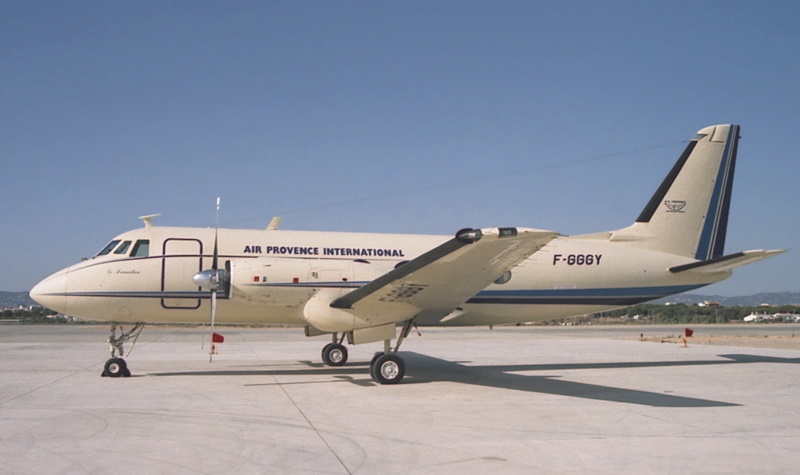
There was a hydraulically-operated airstair door on the forward left fuselage, a baggage door on the right rear, and five passenger windows on each side. The windows were large flattened ovals, that being an ongoing characteristic of the Gulfstream line; they provided an excellent view. The cabin had stand-up room -- 1.85 meters (6 feet 1 inch) height, 2.24 meters (7 feet 4 inch) width -- and was pressurized; passenger seating could vary from 8 in an executive layout to 19 in a high-density layout, with three across. "Green" aircraft were passed on to other firms for interior fit -- a common practice now, but yet another innovation then. There was no default interior fit, and it appears some accessories like weather radar were also customer-specified.
___________________________________________________________________
GRUMMAN GULFSTREAM I:
___________________________________________________________________
wingspan:
23.88 meters (78 feet 4 inches)
wing area:
57.13 sq_meters (615 sq_feet)
length:
19.43 meters (63 feet 9 inches)
height:
6.93 meters (22 feet 9 inches)
empty weight:
9,520 kilograms (20,900 pounds)
max take-off weight:
15,920 kilograms (35,100 pounds)
max speed:
575 KPH (355 MPH / 310 KT)
cruise speed:
535 KPH (335 MPH / 290 KT)
service ceiling:
11,245 meters (39,600 feet)
range, max fuel:
4,025 kilometers (2,500 miles / 2,175 NMI)
range, normal:
3,000 kilometers (1,865 miles / 1,620 NMI)
___________________________________________________________________
200 Gulfstream Is were built to end of production in 1969, most of them being flown by small airlines, or as executive / utility aircraft -- one prominent corporate machine was flown by Disney Corporation, shuttling Disney crew from Anaheim to Orlando during the construction of Disney World. It is now discreetly on display at Disney World.
One was flown by the US Coast Guard (USCG) as a VIP transport, primarily for the USCG commandant, later as a utility and command-control aircraft, under the designation of "VC-4A". Nine of them were built as systems trainers for the Grumman A-6 Intruder attack aircraft, having an A-6 nose containing combat systems tacked onto them, featuring four student consoles; these trainers were designated "TC-4C Academe". The Navy also considered buying a batch of "TC-4B" navigation trainers, but it didn't happen.
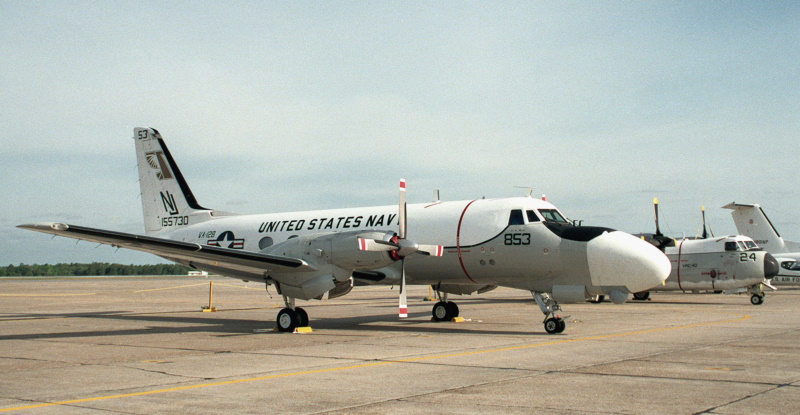
Five Gulfstream Is were "stretched" by 3.25 meters (10 feet 8 inches) to provide a maximum of 37 seats -- two emergency exits were added on the right side of the aircraft -- these five machines becoming the "Model G-159C" AKA "Gulfstream IC". There was no great interest in them, and the exercise wasn't continued. There was consideration of other updates of the Gulfstream I, but by the end of the 1960s, it was obsolete compared to other small turboprops. The engines were fuel-hungry and noisy.
A few Gulfstream Is linger in service; four are flown by Phoenix Air, a US firm that provides military training services. Two of these machines feature tandem belly antenna fairings, a litter of other antennas, a pod under each outer wing, and can carry towed decoys under the fuselage. Two others are less adorned, but can carry and control two Northrop Chukar target drones each. Phoenix Air would later acquire jet Gulfstreams, focused on charter flight operations.
BACK_TO_TOP* By 1965, Grumman was becoming concerned over competition from jet-powered executive aircraft like the Dassault Falcon 20, Hawker Siddeley HS.125, Lockheed Jetstar, and North American Sabreliner. The Gulfstream I had better range and comfort, but customers wanted jet speed.
The introduction of the Rolls-Royce Spey second-generation turbofan meant a powerplant was available that provided jet performance, without excessive fuel consumption. Initial flight of the first "Model 1159 Gulfstream II" -- there was no formal prototype -- was on 2 October 1966. Four aircraft were used in certification, which was granted in October 1967, and initial customer deliveries in December. Initial production was from Bethpage, but then taken over by a new plant in Savannah, Georgia. As with the Gulfstream Is, the Gulfstream IIs were built "green" and sent to completion centers, to be fitted out as per customer specification -- and so, there was no default fit. Maximum certified passenger load was 19 seats.
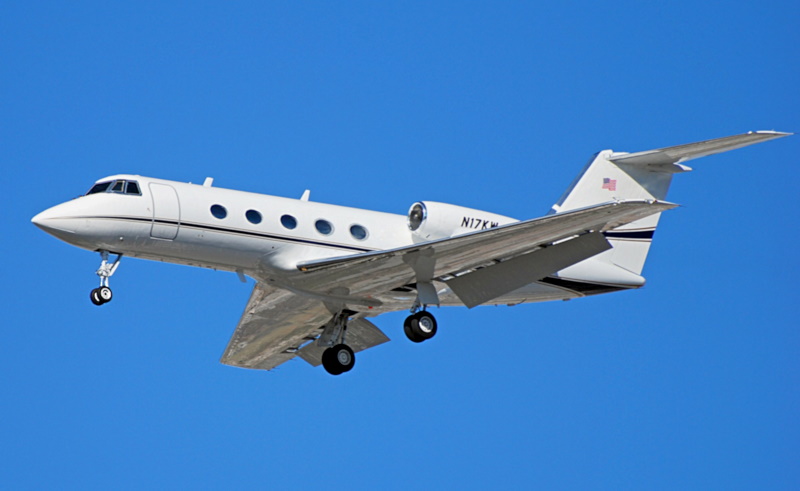
The Gulfstream II was built around the fuselage of the Gulfstream I -- with the airstair door on the front left fuselage, and five flattened-oval windows on each side -- and had the same general landing gear scheme -- all dual wheels, nose gear retracting forward, but with main gear retracting inward from the wings towards the fuselage. It differed in having a Rolls-Royce Spey RB.168 Mk 511-8 turbofan engine -- with 51 kN (5,170 kgp / 11,400 lbf) thrust and thrust reverser -- on each side of the tail, and all-swept flight surfaces, including a low-mounted wing and a tee tail. Later production had engine "hushkits" to reduce noise levels. Fuel capacity was 12,725 liters (3,360 US gallons) in wing tanks, with single-point refueling.
The GII had a conventional flight control surface arrangement, including large one-piece Fowler flaps, plus dual spoilers ahead of each flap for roll control and to act as airbrakes. All flight surfaces were hydraulically actuated. The wings had a sweep of 25 degrees, and featured small vortex generators, plus a wing fence near midspan; they were de-iced by engine bleed air. There was a stick shaker / pusher to give stall warning. The aircraft was well-received, with a more comfortable cabin than the cramped cabins of the competition, and top performance by the standards of the era.
___________________________________________________________________
GRUMMAN GULFSTREAM II:
___________________________________________________________________
wingspan:
20.98 meters (68 feet 10 inches)
wingspan, tip tanks:
21.87 meters (71 feet 9 inches)
wing area:
75.21 sq_meters (809.6 sq_feet)
length:
24.36 meters (79 feet 11 inches)
height:
7.47 meters (24 feet 6 inches)
empty weight:
13,775 kilograms (30,365 pounds)
max take-off weight:
29,710 kilograms (65,500 pounds)
max cruise speed:
935 KPH (580 MPH / 505 KT)
normal cruise speed:
775 KPH (485 MPH / 420 KT)
service ceiling:
13,105 meters (43,000 feet)
range, max fuel:
6,880 kilometers (4,275 miles / 3,720 NMI)
range, max payload:
5,300 kilometers (3,290 miles / 2,860 NMI)
___________________________________________________________________
One Gulfstream II was obtained by the US Coast Guard (USCG) as a VIP transport, being designated "VC-11A". The US Army would also obtain two Gulfstream IIs second-hand, and similarly designate them VC-11A.
In 1969, Grumman established a subsidiary organization to build the Gulfstream; that exercise was followed in 1973 by acquisition of American Aviation Corporation, which built a series of light civil aircraft; the resulting "Grumman American" organization inherited Gulfstream production. In 1978, Grumman sold off Grumman American to American Jet Industries, headed by entrepreneur Alan Paulson -- who renamed the firm "Gulfstream American".
By the time the Gulfstream II was in production, the parent organization had become "Grumman American" and then "Gulfstream American". The baseline Gulfstream II was followed by the "Gulfstream II TT" -- "TT" for "tip tanks" to provide extended range. The tip tanks had been certified even before customer deliveries of the original Gulfstream II, and had been sold as an option. With the Gulfstream II TT, they were standard, though customers could opt not to have them.
256 Gulfstream IIs / II TTs were built to end of production in 1979. In the 1980s, 43 Gulfstream IIs were updated with the avionics and wider, wingleted wings of the follow-on Gulfstream III; these machines were redesignated "Gulfstream IIB". Gulfstream IIs were flown in a number of special-mission configurations:
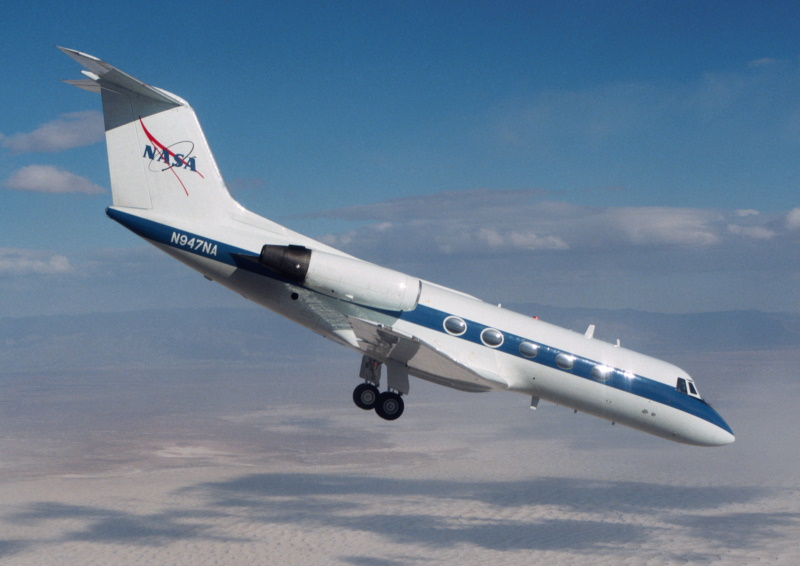
In the 1990s, some Gulfstream IIs had Aviations Partners winglets attached to their existing wings; the vortex generators and the wing fences were removed, being replaced by leading-edge "vortilons". From 2013, Gulfstream IIs have been updated to new engines, or have been fitted with hushkits, to meet engine noise limits.
Gulfstream IIs have been flown in small quantities in government service as VIP / utility aircraft by Gabon, Libya, Morocco, Nigeria, Oman, Panama, and Venezuela.
BACK_TO_TOP* Working from the Gulfstream II, Gulfstream Aerospace decided to give it a make-over, focusing on an update of the wings -- featuring an increase in span and winglets -- along with a fuselage stretch. Initial flight of the prototype of the "Model 1159 Gulfstream III" was on 2 December 1979, with introduction to service in 1980.
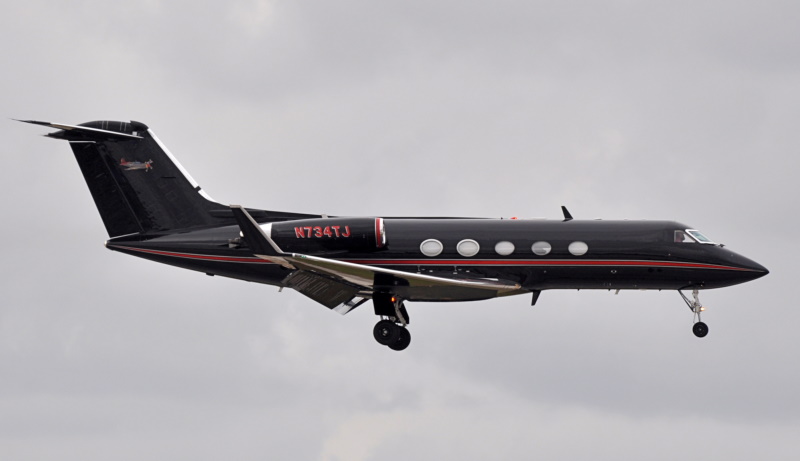
The wingspan was increased by 1.8 meters (6 feet), with the winglets being 1.5 meters (5 feet) tall; the number of spoilers on each wing was increased to three. The fuselage was extended by 1.19 meters (3 feet 11 inches), while the cockpit and windshield were also modified. Powerplants remained the same; it appears the increased aerodynamic efficiency of the new wing compensated for the increase in weight. Fuel storage was increased to 16,655 liters (4,400 US gallons).
___________________________________________________________________
GULFSTREAM III:
___________________________________________________________________
wingspan:
23.72 meters (77 feet 10 inches)
wing area:
86.83 sq_meters (934.6 sq_feet)
length:
25.32 meters (83 feet 1 inch)
height:
7.47 meters (24 feet 6 inches)
empty weight:
14,650 kilograms (32,300 pounds)
max take-off weight:
30,395 kilograms (68,200 pounds)
max cruise speed:
930 KPH (575 MPH / 500 KT)
normal cruise speed:
820 KPH (510 MPH / 445 KT)
service ceiling:
13,715 meters (45,000 feet)
range, max payload:
6,760 kilometers (4,200 miles / 3,650 NMI)
___________________________________________________________________
Gulfstream American became "Gulfstream Aerospace" in 1982; it was then bought out by Chrysler Corporation in 1985, in an attempt to diversify. A total of 202 Gulfstream IIIs was built to end of production in 1986. The US military obtained a total of 17 of them, for VIP / utility use, variants including:
In 1983, the Danish Air Force obtained three Gulfstream IIIs with Texas Instruments AN/APS-127 sea search radar, with the antenna on the belly centerline, and other enhanced avionics, plus a flare drop chute. These machines were given the designation of "Special Mission Aircraft 3 (SMA-3)"; they were otherwise kitted for the cargo-transport role, featuring a large cargo door on the forward right fuselage, being used for maritime and fisheries patrol, search and rescue, and VIP transport / utility aircraft. The SMA-3s were eventually sold off to private companies.
From 1984, Gulfstream flew a demonstrator for special-mission configurations of the Gulfstream III, designated the "SRA-1". It featured fairings for a synthetic aperture radar (SAR)" under the forward fuselage, and wingtip pods for an "electronic support measures (ESM)" system -- the ESM being intended to locate and identify radio "emitters". They were dummies, no such systems being fitted, though the aircraft did carry a working long-range optical (LOROP) camera.
There were three stores pylons under each wing, and a large cargo door; the cargo door was apparently not only to support getting large pieces of electronics gear in and out, but to give the aircraft a secondary cargolifter role. Grumman used the demonstrator to show off other possible features, including an inflight-refueling probe; an inflight-refueling tanker pod; and countermeasures gear, including radar warning receiver and chaff-flare dispensers.
The SRA-1 was effectively a showcase for the possibilities of Gulfstream special-mission aircraft, not a product in itself. The Indian Air Force did buy two Gulfstream IIIs for special missions, with the aircraft delivered in 1986. They may also have had some signals intelligence (SIGINT) gear.
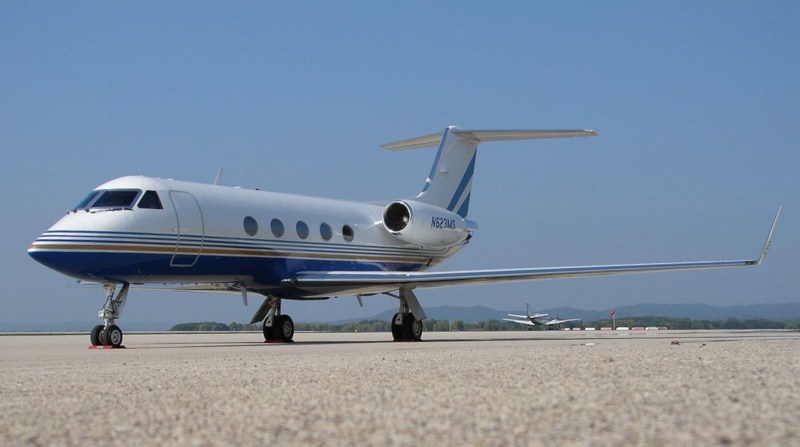
A number of Gulfstream IIIs have also been used as trials platforms. Along with the US, Denmark, and India, Gulfstream IIIs were obtained by the governments of Algeria, Cameroon. Ivory Coast, Gabon, Ghana, Italy, Ireland, Mexico, Morocco, Oman, Saudi Arabia, Togo, Uganda, Venezuela, and Zimbabwe. Many Gulfstream IIIs remain in service; from 2013, those still flying had to be fitted with hushkits to reduce their noise levels to legal levels.
BACK_TO_TOP* In 1983, Gulfstream Aerospace began work, in collaboration with Grumman, to rethink the Gulfstream, with the initial prototype of the "Gulfstream IV" flying on 19 September 1985, and deliveries in 1987. Changes included:
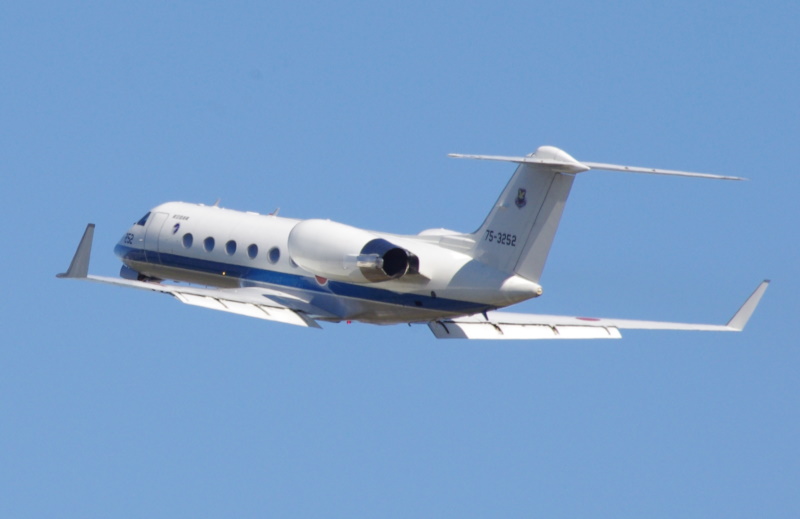
Range was increased by 22%. Gulfstream offered standard cabin configurations for the GIV, emphasizing executive layouts. Mainline production went to the "GIV-SP" -- "SP for "special performance" in 1993, which soon became the "G400". It featured payload weight increased by 1,135 kilograms (2,500 pounds) and updated avionics.
___________________________________________________________________
GULFSTREAM IV:
___________________________________________________________________
wingspan:
23.72 meters (77 feet 10 inches)
wing area:
88.29 sq_meters (950.39 sq_feet)
length:
26.92 meters (88 feet 4 inches)
height:
7.57 meters (24 feet 10 inches)
empty weight:
16,100 kilograms (35,500 pounds)
max take-off weight:
33,200 kilograms (73,200 pounds)
max cruise speed:
945 KPH (585 MPH / 510 KT)
normal cruise speed:
840 KPH (525 MPH / 455 KT)
service ceiling:
13,715 meters (45,000 feet)
range, max fuel:
7,820 kilometers (4,859 miles / 4,225 NMI)
range, max payload:
6,845 kilometers (4,255 miles / 3,700 NMI)
___________________________________________________________________
Chrysler decided that getting into aviation wasn't such a good idea, and sold off Gulfstream Aerospace in 1989, to a group led by Paulson. It would be sold off again ten years later, to General Dynamics (GD). GD had previously sold off their aircraft division, which made the F-16 Viper, to Lockheed in 1993; the Gulfstream acquisition put GD back into the aircraft business. At last notice, GD still owns Gulfstream.
In any case, the US military obtained the Gulfstream IV, flying it in the VIP / utility role, with variants including:
One GIV was obtained by the US Federal Aviation Administration as a VIP transport. One GIV-SP was flown by the US National Oceanic & Atmospheric Administration (NOAA, an arm of the Department of Commerce) as a "Hurricane hunter", flying above tropical cyclones to drop probes, or "dropsondes", into the storm. This machine featured a modified nose, presumably to accommodate an improved radar; it was eventually fitted with a side-scanning Doppler radar in a prominent tail extension for storm observation. A shorter-range variant with 10% less fuel capacity, the "G300", was introduced in 2002.
In 2001, work began on an improved version of the GIV-SP, originally designated "GIV-X", being later renamed "G450". It was announced in 2003, with first flight of four development aircraft on 30 April 2003, certification in 2004, and customer deliveries from 2005. The G450 featured:
A shorter-range "G350" was introduced in 2004 -- it was generally identical, but with fuel supply reduced from 16,602 liters (4,386 US gallons) to 14,471 liters (3,823 US gallons). The last of the GIV series was delivered in 2018, over 900 having been built. It was replaced by the Gulfstream 500.
Along with civil operators, the Gulfstream IV or its variants was obtained in the VIP-utility role by the governments of Botswana, Brunei, Chile, Ivory Coast, Egypt, Ireland, Jordan, Japan, Malaysia, Mexico, Netherlands, Pakistan Saudi Arabia, Sweden, Turkey, Uganda, United Arab Emirates, and Venezuela.
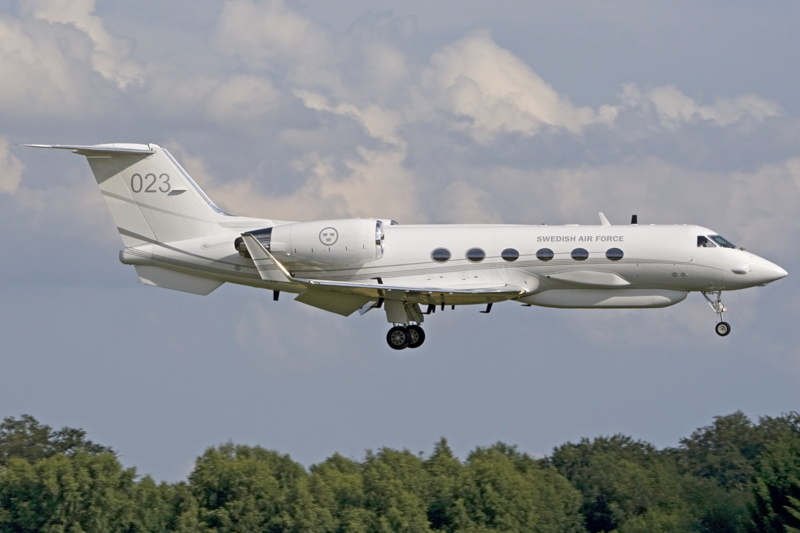
Grumman promoted an "SRA-4" special mission configuration for the Gulfstream IV. This led to a 1992 purchase by Sweden of two GIVs configured as SIGINT platforms, with a canoe fairing under the nose. These two aircraft were initially given the designation of "TP 102B Korpen (Raven)". The "TP" code indicated a transport; the designation was changed to "S 102B" to reflect their use for SIGINT.
The "Raven" name for the S-102B reflected the common nickname for EW crews as "crows" or "ravens", but it had special significance in Sweden, since in Norse mythology ravens were the eyes and ears of the uber-god Odin. He would send his two ravens, "Hugin" and "Munin", to the corners of the Earth, and they would return and whisper what they had seen in his ears. Of course, the two S-102Bs were given the names of Odin's ravens. The Swedes also obtained a GIV and GIV-SP as VIP transports, under the designation of "TP 102A".
The Korpens flew in support of operations in Libya in 2011, in Syria in 2020, and in Baltic air patrols from 2022 -- the last at the time when Sweden was anticipating becoming a NATO member. The Korpens are still in service; not much is known about their kit, which has presumably been upgraded during their long service.
BACK_TO_TOP